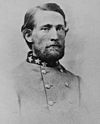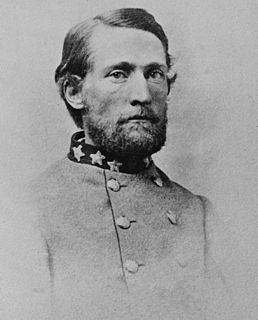
John Singleton Mosby, also known by his nickname, the "Gray Ghost", was a Confederate army cavalry battalion commander in the American Civil War. His command, the 43rd Battalion, Virginia Cavalry, known as Mosby's Rangers or Mosby's Raiders, was a partisan ranger unit noted for its lightning-quick raids and its ability to elude Union Army pursuers and disappear, blending in with local farmers and townsmen. The area of northern central Virginia in which Mosby operated with impunity became known as Mosby's Confederacy. After the war, Mosby became a Republican and worked as an attorney, supporting his former enemy's commander, U.S. President Ulysses S. Grant. He also served as the American consul to Hong Kong and in the U.S. Department of Justice.

The Battle of Aldie took place on June 17, 1863, in Loudoun County, Virginia, as part of the Gettysburg Campaign of the American Civil War.

The Battle of Middleburg took place from June 17 to June 19, 1863, in Loudoun County, Virginia, as part of the Gettysburg Campaign of the American Civil War.
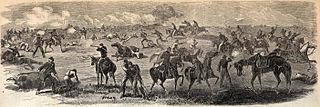
The Battle of Upperville took place in Loudoun County, Virginia on June 21, 1863 during the Gettysburg Campaign of the American Civil War.

Aldie is an unincorporated community and census-designated place (CDP) located between Chantilly and Middleburg in Loudoun County, Virginia, United States. The historic village of Aldie is located on the John Mosby Highway in a gap between the Catoctin Mountains and Bull Run Mountains, through which the Little River flows. Aldie traditionally serves as the gateway to the Loudoun Valley and beyond.

The Loudoun Valley is a small, but historically significant valley in the Blue Ridge Mountains located in Loudoun County in Northern Virginia in the United States.
U.S. Route 50 is a transcontinental highway which stretches from Ocean City, Maryland to West Sacramento, California. In the U.S. state of Virginia, US 50 extends 86 miles (138 km) from the border with Washington, D.C. at a Potomac River crossing at Rosslyn in Arlington County to the West Virginia state line near Gore in Frederick County.
Loudoun County, Virginia, was destined to be an area of significant military activity during the American Civil War. Located on Virginia's northern frontier, the Potomac River, Loudoun County became a borderland after Virginia's secession from the Union in early 1861. Loudoun County's numerous Potomac bridges, ferries and fords made it an ideal location for the Union and Confederate armies to cross into and out of Virginia. Likewise, the county's several gaps in the Blue Ridge Mountains that connected the Piedmont to the Shenandoah Valley and Winchester were of considerable strategic importance. The opposing armies would traverse the county several times throughout the war leading to several small battles, most notably the Battle of Balls Bluff.
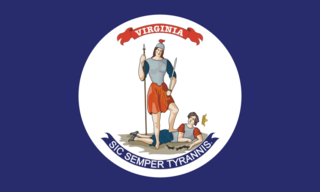
The 43rd Virginia Cavalry Battalion, also known as Mosby's Rangers, Mosby's Raiders, or Mosby's Men, was a battalion of partisan cavalry in the Confederate Army during the American Civil War. Noted for their lightning strike raids on Union targets and their ability to consistently elude pursuit, the Rangers disrupted Union communications and supply lines.
The Skirmish at Miskel Farm, also known as the Fight at Miskel Farm or Gunfight at Miskel Farm, was a skirmish during the American Civil War. It took place April 1, 1863, near Broad Run in Loudoun County, Virginia, between Mosby's Rangers and the 2nd Pennsylvania Cavalry as part of Mosby's operations in Northern Virginia. The 2nd Pennsylvania surprised and attacked the Rangers, who were bivouacked on the farm of Thomas Miskel. The Rangers successfully defended the attack and subsequently routed the 2nd Pennsylvania, inflicting heavy casualties and taking many prisoners.

The Battle of Unison or Battle of Union refers to a series of American Civil War cavalry skirmishes in Loudoun County, Virginia, between October 31 – November 2, 1862, between the Confederate forces of J.E.B. Stuart and various units of the Union Army of the Potomac. Although driven from the field in individual engagements, Stuart accomplished his mission to delay the enemy and screen the movements of the retreating Army of Northern Virginia.
The Battle of Loudoun Heights was a small cavalry skirmish during the American Civil War between John Mosby's Rangers and Major Henry A. Cole's 1st Potomac Home Brigade Maryland Cavalry on January 10, 1864, in Loudoun County, Virginia. Cole's Cavalry successfully defended a night raid against their camp on Loudoun Heights. The fight was one of the first engagements in which Union forces held their own against Mosby's vaunted partisans.
The action at Mount Zion Church was a cavalry skirmish during the American Civil War that took place on July 6, 1864. The skirmish was fought between Union forces under Major William H. Forbes and Confederate forces under Colonel John S. Mosby near Aldie in Loudoun County, Virginia as part of Mosby's Operations in Northern Virginia. After successfully raiding the Union garrison at Point of Rocks, Maryland, Mosby's Rangers routed Forbes's command, which had been sent into Loudoun County to engage and capture the Rangers. The fight resulted in a Confederate victory.
The Second Battle of Dranesville, also known as the Ambush at Anker's Shop, was a small cavalry skirmish that took place between Confederate forces under Colonel John Mosby and Union forces under Captain James Sewall Reed east of Dranesville, Virginia in Loudoun County near present day Sterling on February 22, 1864 as part of Mosby's operations in Northern Virginia in the American Civil War. After successfully defending a raid into "Mosby's Confederacy" by Cole's Maryland Cavalry, the following day Mosby led his Rangers against a second raid by Reed. The action resulted in a Confederate victory.
The Harmony Skirmish was a small engagement of the American Civil War between Confederate forces under Colonel John Mosby and Union forces under Colonel Marcus Reno on March 21, 1865, near the village of Harmony in Loudoun County, Virginia. A union raiding party, that was sent into Loudoun County to eliminate Confederate partisans, was ambushed by Mosby's Rangers near the village of Harmony. After inflicting light casualties on the Federals, the Rangers were unable to drive off the numerically superior and better equipped force and were compelled to withdraw. The skirmish, which was the last major action of the war within Loudoun, was tactically inconclusive.

The Burning Raid was a Union raid conducted in the Loudoun Valley of Loudoun and Fauquier counties in Virginia in 1864 during the American Civil War. It was aimed at destroying the forage on which Confederate partisans operating in the area, specifically Mosby's Rangers, subsisted as well as at breaking the will of the citizens of the area for supporting the partisans.
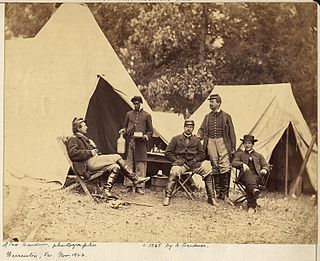
Timeline of Fauquier County, Virginia in the Civil War

The Battle of Fairfax Court House was fought during the Gettysburg Campaign of the American Civil War between two cavalry detachments from the Union Army of the Potomac, commanded by General Joseph Hooker, and the Confederate Army of Northern Virginia, commanded by General Robert E. Lee.

The Warrenton Junction Raid was a surprise attack by Confederate guerrilla warriors on a Union cavalry detachment during the American Civil War. The raid took place near a railroad junction in Virginia's Fauquier County, less than 10 miles (16 km) from the town of Warrenton. Confederate Major John S. Mosby led the attack against about 100 men from the Union's 1st (West) Virginia Cavalry. At first, the raid was very successful, as many of the Union soldiers surrendered to the rebels. The remaining portion of the surprised force was surrounded in a house, and two of their leaders were wounded. The house was set on fire, and the Union soldiers surrendered. As Mosby's men rounded up prisoners and horses, a detachment of the 5th New York Cavalry surprised the rebels and rescued most of the captured Union soldiers. After a short fight, more men from the 5th New York, and the 1st Vermont Cavalry, joined in the pursuit of Mosby's fleeing rebels.

The 18th Pennsylvania Cavalry Regiment was a cavalry regiment of the Union Army during the American Civil War. The regiment was present for 50 battles, beginning with the Battle of Hanover in Pennsylvania on June 30, 1863, and ending with a skirmish at Rude's Hill in Virginia during March 1865. A majority of its fighting was in Virginia, although its first major battle was in Pennsylvania's Gettysburg campaign. It was consolidated with the 22nd Pennsylvania Cavalry Regiment on June 24, 1865, to form the 3rd Provisional Pennsylvania Cavalry Regiment.















